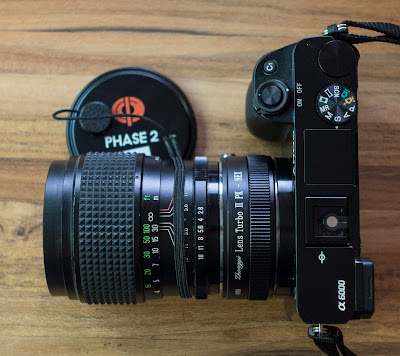This lens was made by a Pentax subsidiary, specialised in Closed Circuit Television lenses. At some point, they decided to make SLR lenses, at a lower cost then the standard quality Pentax lenses. But was it based on real Pentax designs, with Pentax quality, or based on a cheaper, lower quality, design?
At first glans, the lens looks solid, with a nice build-in lens hood. It looks exactly how a decent lens should look like. Both focus and aperture rings work smoothly. The lens must have been well kept, as it looks pristine, fresh from the factory.
But how is the quality? Being a simple prime lens of Pentax heritage, it should be pretty good. Well, it was actually capable of taking good pictures, but often lacked true sharpness. Difficult to get it exactly in the right focus. Not bad, but not spectacular. An online source specifies that the Phase One lenses lack any coating, but does not seem to be the case for this one as it specifies multi-coating, and seems to get a nice color without to much color editing needed.
Bokeh is not bad, but sometimes a little busy...
So, conclusion... not a bad lens, but I would not go hunting for another one. For not much more, you can get a true Pentax lens that is just that much better. Then again, with $12.99, you can't go wrong!
Lens Specification:
Focal Length: 135mm
Maximum Aperture: F2.8
Minimum Aperture: F16
Image Format: 35mm
Lens Mount: PK
Optics: ? elements in ? groups
Blades: 6
Focussing: Manual
Minimum Focus: 150cm
Filter Size: 55mm
Weight: 350g
Length: 73-85mm
Production: 1982 or earlier
Serial Number: 322699
Made In: Japan
From a 1982 magazine:

Company:
CPC, or Combined Product Corp. seems to be an importer/rebadger of Japanese lenses, mainly made by Cosmicar, subsidiary of Asahi Precision Co. Ltd, also the owner at the time of the Pentax brand. They seem to be very similar to Pentax design, but were sold at about a 20% lower cost than similar Pentax lenses. Questions is if they have the same quality or not. Some seem to have good reviews.
MC
MC stands for Multi Coated, a multi-layer lens coating process that cuts the reflection ratio down with as result a dramatic improvement in both color fidelity and brightness and the elimination of flare and ghost images.
CCT
For many years Asahi Optical has been making closed circuit television (CCT) lenses in many forms, under the trade name Cosmicar. It is assumed that CCT provides the mark of a Cosmical produced lens, but this time for 35mm SLR.
Adapter:
Lens Turbo II PK - Nex
Cost: $75, used on B&H PhotoVideo, new for $149
The Pentax K Lens to Sony E-Mount Camera Lens Turbo Adapter Mark II from Mitakon allows Pentax K lenses to be mounted on Sony E-Mount APS-C format cameras, increasing the angle of view by 0.726x and the maximum aperture of the lens by 1 f-stop.The four optical elements of the Lens Turbo adapter condense light from the Pentax K full frame lens and project it onto the camera's APS-C sensor allowing the sensor to capture all of the lens' transmitted light, negating the 1.5x crop factor and effectively producing full-frame coverage on non-full-frame sensors. A corresponding increase in the maximum aperture of 1 f-stop makes the lens more effective in low-light situations.
The Mark II version of the Lens Turbo features an improved design to produce sharper images. Its rectangular rear lens rests closer to the camera's sensor improving light transmission and an enhanced lens coating minimizes ghosting and flare. One extra-low dispersion (ED) lens element reduces aberrations for better delineated images. The adapter offers a sturdy metal construction and stainless steel mounts, it attaches to both camera and lens with little play and includes a front and rear protective cap. The Lens Turbo is a manual adapter offering no electronic communication between lens and camera.














No comments:
Post a Comment